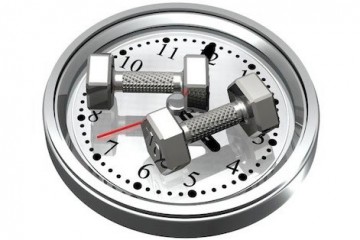How to Lose Fat
Reducing your total body fat not only helps you lose weight, but also can have significant improvements on your health. Lowered risk of heart disease, diabetes, hypertension and sleep apnea are just a few benefits of losing excess fat.[1] When you're trying to lose weight, it's ideal to lose only excess fat. However, without proper planning, dieting can also lead to the loss of lean muscle mass.[2] While you'll see a reduction in your overall weight, losing muscle mass may lead to weakness, fatigue, poor athletic performance, and decreased metabolism.[3] A well balanced diet can help you lose excess fat mass, can help minimize muscle loss and improve your overall health.
Steps
Part 1 Exercising to Decrease Fat
-
1
Include cardio exercises. Cardio is the quickest way to burn calories immediately. Include moderate to vigorous intensity exercise a few times a week and focus on exercises that involve intervals to aid in fat burning. This will help burn calories from fat in addition to boosting your cardiovascular health.[4]
- Aim to include at least 150 minutes of moderate intensity (where you can say a short sentences fairly easily) activity each week. However, adding in vigorous activity (where you can't say more than one to two words at a time) burns more calories per minute.[5]
- You don't have to force yourself to pound the pavement in a dead sprint. Swimming, cycling, boxing, and tennis all offer effective alternatives to running and elliptical machines.
- If you're not quite ready for vigorous exercise, start walking briskly on a treadmill at an uphill climb, use a stationary bike, or get acquainted with an elliptical machine. You can do these at a level catered to your ability.
- To lose the most amount of fat, a combination of weight training and cardio is the most effective exercise plan.[6]
-
2
Build muscle with strength training. Although cardio burns more calories in the short-term, weight lifting or strength training helps build lean muscle mass that can increase how many calories you burn over the long-term.[7]
- Include at least 20 minutes of strength training at least two times a week. However, the more time you spend doing strength training exercises, the more lean muscle mass you can build.[8]
- Gaining lean muscle can work wonders for your metabolism. Studies have shown that increased muscle mass helps increase your metabolism and burn more calories even when your body is at rest.[9]
-
3
Include interval training. Exercise does increase your metabolism, but interval training does so even more. High-intensity interval training has been shown to be more effective at burning calories from fat than other forms of exercise.[10]
- Interval training has also been shown to increase your metabolism and keep it raised for up to 24 hours after your work out.[11]
- Interval training is a short workout that alternates between short bursts of very high intensity activity and moderate intensity activity. These workouts should last between 15-25 minutes and you should feel very, very out of breath at the end of the workout.[12]
- Interval training can be difficult and may not be appropriate for all fitness levels. Always speak to your doctor and take your first interval training workout slowly until you feel comfortable with it.
-
4
Increase your lifestyle activity. Lifestyle activity are activities and movement that you do in a typical day. Increasing how much you move throughout your daily routine can help burn more calories and fat.[13]
- Lifestyle activity typically falls into low to moderate intensity exercise. That means, you're active, heart rate is raise slightly but you're not out of breath. Activities may include: walking to and from your car, walking while you grocery shop, taking the stairs to your office or household chores (like mopping or gardening).
- These types of activities fall into a category known as the "fat burning zone." Although you burn less calories overall in this zone, the calories burned are primarily from fat stores.[14]
- A combination of planned exercise (like a 30 minute jog) in addition to increase lifestyle activity (like parking your car farther from the door) can help you lose a significant amount of fat mass.[15]
-
5
Exercise at home. If you find it difficult to get out and exercise or do not have a gym membership, there are a variety exercises that you can do at home with little or no equipment.
- If you're a beginner, try walking in place, leg lifts from a chair, or wall push ups. These are low intensity, beginner exercises that can help burn calories, tone muscle and help you reduce fat mass.
- If you are a intermediate exerciser, you can try more advanced exercises at home. Include activities like: push-ups, sit-ups, running in place, squats, or mountain climbers. These are activities that will get you sweating and help reduce fat mass.
Part 2 Changing Your Eating Habits
-
1
Consume more protein. Excessive amounts of protein won't build muscle mass (the only way to build muscle is to work your muscles), but it will support your goal to lose weight and reduce excess fat.[16]
- Lean protein can help support your weight loss and keep you feeling satisfied longer compared to carbohydrates.[17]
- In general, women need 46 grams of protein daily and men need about 56 grams of protein daily.[18] Including 1 serving of protein at each meal and snack can help you meet this goal.
- A serving of meat, poultry, or fish, should be the size and thickness of the palm of your hand (which is about 3-4 oz).
- Lean protein to include in your diet can be: eggs, poultry, low-fat dairy, lean beef, legumes, pork, seafood and tofu.
-
2
Limit carbohydrates. Studies have shown that low-carb diets result in greater initial weight loss and greater fat reduction long-term compared to low-fat diets.[19] Limiting the amount of carbohydrates you consume can help you lose weight, but specifically reduce the amount of excess fat you carry.
- Carbohydrates are found in a wide variety of foods including: fruit, dairy, legumes, grains and starchy vegetables. Because they are so wide spread, it's not ideal or safe to go on a very-low or no-carb diet as you would be limiting a large variety of foods. Aim to consume a moderate amount of carbohydrates, not avoid them.
- Limit carbohydrates from grains like bread, rice, pasta or crackers as these foods are not as nutrient dense as other carbohydrates like starchy vegetables or fruit.[20] It's also important to limit grains that are refined or made from white flour like white bread, plain pasta, or white rice.
- If you're choosing to consume a grain-based food, choose 100% whole grains over refined grains. Whole grains are higher in fiber and other nutrients that are healthy for you.[21] Choose foods like: 100% whole grain bread, brown rice, or whole grain oats.
-
3
Eat a healthy, balanced diet. If your goal is to lose fat you may be focusing on lean protein and limiting carbs, but it's also important to make sure that you're still eating a fairly balanced diet. That means including fruits and vegetables as well.[22]
- Fruits and vegetables are important parts of a balanced diet because they provide a host of nutrients including: fiber, vitamins, minerals, and antioxidants.[23]
- Choose a variety of fruits and vegetables each day. Aim to have one to two servings of fruit daily which is either 1 small fruit or 1/2 cup chopped fruit.[24] Also have about three to four servings of vegetables daily which is about 1 cup or 2 cups leafy greens.[25]
-
4
Avoid sugar and alcohol. Studies have shown that both sugar and alcohol can cause weight gain, but specifically increase the amount of excess fat.[26] Cutting out or limiting these foods may help you lose weight and decrease the amount of excess fat you have.
- Current recommendations say to limit alcohol to one glass daily for women and two glasses daily for men. However, limiting alcohol further is ideal for weight and fat loss.[27]
- Limit or avoid foods that are high in sugar like: candy, cookies, cakes, sweetened beverages (regular soda or sweetened tea), sweetened coffee drinks, fruit juices, or sports/energy drinks.
-
5
Avoid dieting pills. There are a variety of pills on the market that promise a host of dieting benefits — including quick weight and fat reduction. Diet pills are not regulated by the FDA and may have serious consequences. These fads are not only potentially dangerous, they are also not proven effective.
- Some studies conducted by the FDA found that many of these over-the-counter diet pills have been tainted or contaminated with other harmful medications or are a combination of medications that is harmful to your body.[28] Take great caution prior to consuming any diet pills.
- Do not take any over-the-counter medications without consulting with your doctor first. These medications may interfere with your prescription medications or current health conditions.
- Avoid pills or products that claim quick or easy weight fixes. For example "lose 10 pounds in 1 week" or "drop 2 pant sizes in 2 days." If it looks easy and too good to be true, it probably is. Err on the side of caution and avoid these.
Part 3 Maintaining New Eating Habits
-
1
Keep a food journal. Jotting down notes about what you eat can help you stay on track with a diet or new eating habits long-term. These check-ins help you stay accountable and understand exactly what's being eaten everyday.[29]
- Keeping a food journal can also help you become aware of any "slip-ups" or help you see where there are areas for change if needed.
- Purchase a food journal notebook, use a few pieces of scrap paper, or download a journaling app on your smart phone or tablet.
- Make sure you are being honest and accurate in your food journal. People have a tendency to under-estimate how much they eat.
-
2
De-stress regularly. Studies have shown that increased stress levels can raise your cortisol levels. This is a hormone frequently referred to the "fight or flight" hormone. When it's raised from chronic stress it can increase fat stores in your body — especially in your midsection.[30]
- Stress is hard to escape. But taking measures to become aware of what causes stress in your life and how to manage it will help reduce the risk of increasing fat mass.
- Increased fat mass, especially in your midsection, has been associated with increased health risks including: obesity, diabetes, and hypertension.[31]
- Try meeting with a life coach or behavioral therapist if you feel your stress is too hard to control or you need a little extra help getting it under control. These health professionals will be able to give you guidance on how to best manage stress.
- Write a list of ideas or activities that are relaxing or soothing for you. When you feel stressed, try to engage in these activities to help calm you down. You can try: listening to music, going for a walk, reading a good book, or talking to a friend.
-
3
Take measurements. As you continue to diet, exercise, and lose weight, a good way to measure your progress is to regularly weigh yourself or take your measurements. This can be a motivator for you to keep on going.[32]
- Weigh yourself about one to two times a week. Aim for the same day of the week and at the same time for the most reliable results.
- Also try taking a variety of body measurements. For example, measure your waist, hips or thighs. As you lose weight and decrease fat, you'll notice your whole body shrinking.
-
Weight Loss Tips To Transform Your Figure!
It is important to address the cause of the problem before coming up
-
How to Get Rid of Flabby Arms
Are you self-conscious about your flabby arms? If this concern is int
-
High Intensity Interval Training Research
High intensity interval training, also known as HIIT, has become
-
Is Your Guy Making You Fat?
A relationship can add so much to your life — including extra weight!
-
Use THIS Ginger Compress To Reduce Your Waist Naturally
Fresh ginger is packed with antioxidants and has anti-inflammatory pr
-
Juice Recipes For Pounds Decline
Below are some juice recipes of my very own creation to help you dro
- DON'T MISS
- How to Lose Weight for Good
- Resistance Training Exercises From The Comfort Of Your Home
- Weight Loss Tips: How To Lose Weight Fast & Easy
- General Information About Control Obesity
- Best Tips For Becoming A Loser In The Weight Loss Battle!
- Weight Loss Motivation - 4 Effective Ways To Encourage Yourself To Lose Weight
- 13 Tips And Tricks For Weight Loss You Really Should Know!
- This Is What Happens When You Skip A Meal
- Are All Carbohydrates Evil?
- Weight Loss Myths And Corresponding Facts




